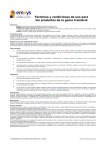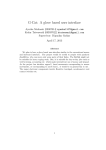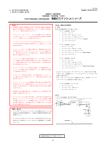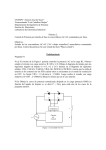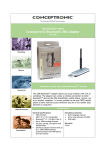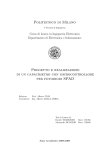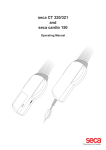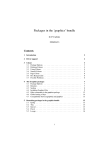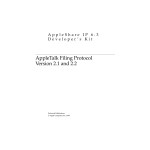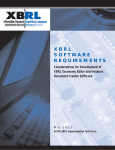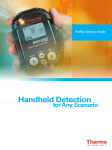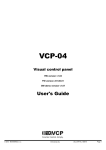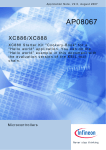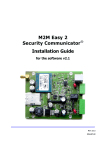Download Manual - Saelig
Transcript
uIceBlue 2 Wireless embedded control module GETTING STARTED MANUAL uIceBlue2 Wireless control module © emxys 2008 All rights reserved emxys reserves the right to make changes and improvements to its products without providing notice. uIceBlue, uIceBlue2, IceBlue and PearlBlue are trademarks of emxys Ltd. Version 2.0 July 2009 2 www.emxys.com [email protected] Table of Contents 1. Introduction and overview. ................................................................................ 6 1.1. The Bluetooth technology. ............................................................................ 6 1.2. The uIceBlue2 Module. ................................................................................. 7 1.3 hola ............................................................................................................... 8 1.4. Requisites. .................................................................................................... 8 2. Connecting uIceBlue2....................................................................................... 10 2.1. Wireless connection. ................................................................................... 10 2.2. ICD2 Connection. ........................................................................................ 13 2.3. Power requirements. .................................................................................. 16 3. Programming uIceBlue2. .................................................................................. 18 3.1. Programming the module with ICD2. .......................................................... 18 4. Pin assignments. .............................................................................................. 20 4.1. Pin Out........................................................................................................ 20 3 www.emxys.com [email protected] Index of Figures Figure Figure Figure Figure Figure Figure Figure Figure Figure Figure Figure Figure 1. The uIceBlue2 module. ............................................................................ 7 2. Bluetooth network with uIceBlue2 ........................................................ 11 3. Windows Device Discovery wizard ........................................................ 12 4. Pin code requirement ............................................................................ 12 5. Entering PIN code to pair the device ..................................................... 12 6. Docklight Serial Terminal screenshot..................................................... 13 7. ICD2 connection scheme ....................................................................... 14 8. ICD2 Programming & Debug port pin-out .............................................. 14 9 . MPLAB IDE environment with an opened project .................................. 18 10. uIceBlue2 Layout ................................................................................. 20 11. uIceBlue2 Internal diagram ................................................................. 21 12. Pin-Out Distribution ............................................................................. 22 4 www.emxys.com [email protected] Index of Tables Table 1. uIceBlue2 main Specifications. ............................................................... 16 Table 2. uIceBlue2 Pin Out. .................................................................................. 22 5 www.emxys.com [email protected] 1. Introduction and overview. Bluetooth is a wireless communication protocol conceived to enable high speed data transfer through portable devices. Its physical layer can be implemented as a light weight, small, inexpensive and low power electronic device and therefore is being mainly used for handheld computers and phones within the consumer electronics market. However, its applications within embedded systems are countless and twofold: on one side, Bluetooth enabled embedded systems may communicate with handheld devices extending its capabilities to supervision, control and data acquisition; on other side, embedded systems may communicate between them easily, at high data rates and at low cost up to 100 meters in distance and even more1. uIceBlue2 module, an evolution of mature uIceBlue, enables the integration of Bluetooth communications within embedded systems fast, easily and effectively. This document provides the information to start with quick hands on practice. 1.1. The Bluetooth technology. Bluetooth is an open specification2 to provide short-range wireless communications. It operates in the unlicensed ISM band at 2.45 GHz using Frequency Hop Spread Spectrum modulation to avoid interference. There are two kind of devices: Class 2 devices reach up to 10 m with a power of 0 dBm; Class 1 devices reach up to 100 m with 20 dBm1. Bluetooth communicates a master and a slave device. Usually each device is able to operate as either master or slave at a time. Bluetooth devices have a unique 48-bit address (BD_ADDR) used as identification. This address defines also the way devices negotiate and start radio communication. The Bluetooth specification defines the implementation of profiles that run over lower layers of the Bluetooth stack. Bluetooth Profiles define a simple way to communicate different devices using a high level protocol. Among several Bluetooth profiles the Serial Port Profile was created to make a simple wireless substitution to the RS232 cable that connects many computers and embedded products. The final goal of Bluetooth was to create a low cost alternative to the wire connection. 1 Although Class 1 Bluetooth can be extended with the use this area. 2 The complete Bluetooth www.bluetooth.com. For beginners a good starting devices are specified to reach distances of up to 100 m, this of directional antennas. Contact emxys for specific solutions in (more than 1000 pages) specification cab be found at point is http://en.wikipedia.org/wiki/Bluetooth. 6 www.emxys.com [email protected] 1.2. The uIceBlue2 Module. The uIceBlue2 module is an embeddable control module based on the USB featured microcontroller PIC18F4550 from Arizona Microchip™. To implement the Bluetooth communication capabilities, the module contains a full featured core of the PearlBlue module on the same board, which is connected to the USART pins of the PIC microcontroller. PearlBlue core device implements the Serial Port Profile and allows simple point to point wireless communication of devices that incorporate this profile over Bluetooth. PearlBlue connects the radio serial port to a physical UART that can be easily interfaced to an embedded microcontroller, microprocessor or computer. Moreover, PearlBlue can work on its own and offer 6 general purpose input/output pins. For a detailed information about the PearlBlue operation and capabilities, refer to the PearlBlue User Manual. PearlBlue, may act as a master or an slave; This feature allows it to wait for connections or to initiate a connection. Therefore, the full power of the PearlBlue module is available in this device both from the air side and from the serial channel (in this case available for the microcontroller code). Figure 1. The uIceBlue2 module. The board offers in a DIP-style double row pin connector the PIC18F4550 pin out, with some exceptions like the clock and power pins. This allow to implement almost any application intended previously for this MCU with no constrain, with the advantage of having together a USB interface combined with Bluetooth serial communications included with no glue code or electronics required. This results in a true glueless solution to embed Wireless Bluetooth communications in any equipment or electronic device with the minimum effort and investment, and a maximum of efficiency. 7 www.emxys.com [email protected] 1.3 User documents More information and documentation about the uIceBlue2 module can be found at the web site http://www.wirelessembedded.com. It is possible to find free documents for all the public, for registered users as well as for customers users. 1.4. Requisites. All necessary information to operate the full capabilities of uIceBlue2 device and its embedded PearlBlue core module are contained in this document and in the PearlBlue User Manual. Due to the fact that the uIceBlue2 module is powered by an Arizona Microchip PIC family Microcontroller, some expertise is needed on these devices to start working. This manual refers to some specific details of the MPLAB integrated Development Environment (IDE) concerning the tools and procedures to work with the uIceBlue2 board, but to get a more basic knowledge we refer to the MPLAB User Manual (for the IDE) and the PIC18F4550 datasheets for an in-depth study of the microcontroller both at the programming level and at the hardware platform operation. 8 www.emxys.com [email protected] 9 www.emxys.com [email protected] 2. Connecting uIceBlue2. uIceBlue2 module enables the integration of Bluetooth communications within embedded systems fast, easily and effectively. In this chapter we will review the basic procedures to initiate the connection from and to the uIceBlue2 module with a remote device via Bluetooth and also how to program the microcontroller and how to initiate an In Circuit Debug session with the Arizona Microchip™ ICD2 debugger. 2.1. Wireless connection. One of the main advantages of the Bluetooth wireless link is its plug and play feature. The current operating systems (running laptops, PDA’s, mobile phones, ...) implement these functions as a part of the software drivers designed for Bluetooth adapters such as USB dongles, PCI or PCMCIA cards and more. The PearlBlue proprietary firmware is not an exception to this, and incorporates all the software procedures needed to enter on an existing Bluetooth network, discover available devices, initiate a link, etc. The uIceBlue2 has the embedded PearlBlue core module configured as a Serial bridge and ready to be discovered by other Bluetooth devices by default. For this working mode to be possible, the uIceBlue2 pin PIO7 must be open or at low state. When pin PIO7 is set, this serial bridge mode is disabled, and the PearlBlue module enters in Command mode. Please refer to PearlBlue Manual for more information about this operation mode. In order to make a first approach to the uIceBlue2 Bluetooth communication, lets suppose we have a set of devices like the following: - A computer with Windows XP SP23. A USB to Bluetooth dongle connected to the computer (we use the Conceptronic™ CBT100U dongle as a reference). An uIceBlue2 Module in a target board that powers it at 3.3 V Other Bluetooth devices (optional) (we use a Nokia S60 smartphones and an iPaq Pocket PC). 3 Other platforms differ in the way the connection is achieved but the procedure involved is similar. 10 www.emxys.com [email protected] Figure 2. Bluetooth network with uIceBlue2 1. Connect a power supply to the target board where the uIceBlue2 module is placed and enable the Bluetooth on the other devices you may have. uIceBlue2’s default start condition is being discoverable The PIO.7 input pin has to be at low state to be able to activate the USART connection (see below at point 4 and PearlBlue Manual for more information about PIO.7 operation). 2. Open the Windows Bluetooth devices manager by clicking twice on the icon at the system tray or into the Control Panel. 3. Click Add device and Next. Windows will try to detect the devices around. 4. You will see a window showing the Bluetooth devices discovered. uIceBlue2 should be among them. By right clicking on any of them you can see its Bluetooth address. 11 www.emxys.com [email protected] Figure 3. Windows Device Discovery wizard In this state, if you double click the device you will be able to discover the services available, which in this case, will be the serial port. If it is the first time you access to the device, you will be asked to PAIR the board. Figure 4. Pin code requirement This consists on an acknowledgement operation to improve the safety in a network highly exposed to intrusion (like the Wireless based ones). By default, the asked key for uIceBlue2 is set as “1111”. Entering this code when required will set the Bluetooth serial port icon highlighted, showing that the virtual COM port is ready to communicate, and also, the software COM number associated to it. Figure 5. Entering PIN code to pair the device It is important to mention that the steps above can appear in a different order depending on the Operating System and the Bluetooth driver version we are using. Perhaps we are required to enter the PIN code in the moment we ask for the available services. In this case, we should receive the services (virtual COM ports) directly after the paring process. In the case that two COM ports appear, they should be labelled as output and input serial ports. Those COM resources are assigned by the Operating system depending on which device initiated the link. In our case, the requirement was sent from the Windows™ drivers, therefore, the communication will be carried out through the output serial port. 12 www.emxys.com [email protected] After this point, we can try to connect the uIceBlue2 by means of this virtual COM port through any serial communication program like WindowsTM Hyperterminal or the GNU software DockLight. Figure 6. Docklight Serial Terminal screenshot 2.2. ICD2 Connection. Aside of tools intended to connect and operate the device via Bluetooth wireless connection by means of the virtual COM port service provided by the embedded PearlBlue core, some resources are needed to develop the software for the PIC microcontroller and to program it with the resulting binary files. For this purpose, we propose as the ideal solution a complete development tool consisting on: 1. The uIceBlue2 module + target board. 2. ICD2 In-Circuit debugger from Arizona Microchip™. 3. MPLAB Integrated Development Environment (IDE) from Arizona Microchip™. The ICD2 is the latest In-Circuit debugger developed by the PIC manufacturer which enables the possibility to run in-circuit debugging over the uIceBlue2-based target board. This consists in to have the uIceBlue2 connected to the ICD2 through the PIC ICSP pins present at uIceBlue2 pin-out by one side, and a computer running the MPLAB IDE connected to the other side to the ICD2 USB or Serial port. The program designed to run on the PIC18F4550 microcontroller is debugged directly on its final platform (in this case, the uIceBlue2 device), but showing online the execution of the code in the simulator included in MPLAB environment in several formats (line-by-line, animation, etc.) and also the contents and variations of the Special Function Register (SFR) values. 13 www.emxys.com [email protected] Therefore, the capabilities available are those which are familiar at the MPLAB simulator (animation, simultaneous code inspection and SFR changes, and so on) but with extended features including the operation of USART and AD conversion. Figure 7. ICD2 connection scheme In the image above we can appreciate the connection scheme of the development system composed by the devices mentioned. It is important to refer to the user to the documentation included in the ICD2 package, which mentions several connection modes. Which we depict here is the USB connection with the PC platform running the MPLAB IDE. No power is needed in this case to supply the ICD2 device. Although power is required to apply to the target. This is motivated to the internal configuration of the logical drivers for programming pins inside ICD2, being supplied from the external side as a requisite. Figure 8. ICD2 Programming & Debug port pin-out 14 www.emxys.com [email protected] In the figure above a layout of ICD2 programming & Debug port pin out is depicted for more information, these programming/debug pins can be found at uIceBlue2 pin-out as directly accessible PIC pins. As it was mentioned, we refer to the ICD2 documentation for further details. 15 www.emxys.com [email protected] 2.3. Power requirements. Although the uIceBlue2 comes with integrated input low-drop out series voltage regulators to power the electronics inside, some limits exist in its operation, shown in the following table. Some of them are maximum rating parameters, so special emphasis is made in the fact that those limits must be carefully observed in any working condition, and in other case, special care must be taken in the case that these parameters could trespass the limitations. Table 1. uIceBlue2 main Specifications. Specification Data Power supply + 3,6 ± 0.1V DC Maximum Rating Vcc = + 12 V DC (Vcc limited by included LDO regulator) Current consumption 150 mA maximum Internal Operation Voltage IO digital Pin voltage / sink/supply current Analog input: voltage range Analog input: impedance Input + 3.3 V 3.3 V / 20 mA (maximum) 0 to + 3.3 V ± 0,8 V (Vref+=Vdd, Vref-=Vss) Zin < 10 KΩ Size 54,3 x 26,2 mm Environmental -40oC to +70oC, 5-95% humidity non condensing Carrier Frequency 2402 MHz to 2480 MHz Radio Power 14 dBm (Class 1) 16 www.emxys.com [email protected] 17 www.emxys.com [email protected] 3. Programming uIceBlue2. uIceBlue2 module enables fast prototyping and development by means of the integrated capabilities of In-Circuit programming and In-Circuit Debugging offered by the family of Flash PIC microcontrollers. We propose as the perfect combination to develop complete embedded solutions based on uIceBlue2 modules the development system composed by the Microchip™ MPLAB Integrated Development Environment (IDE) that can be downloaded from Microchip web page, and the ICD2 In-Circuit debugger from the same manufacturer (this device has to be purchased separately from Microchip). 3.1. Programming the module with ICD2. Once we have configured our MPLAB IDE to work with ICD2 as a programmer & Debugger device (this is possible in the moment of the project creation or at the menu Programmer → Select Programmer → MPLAB ICD 2) we have to connect to it by means of Programmer → Connect. Once we succeed, the only remaining step is to have some binary (.HEX file) at the project or to build successfully a new one pressing Project → Build all, and download the firmware to the microcontroller with the menu command Programmer → Program. This last option must appear when the Connect operation gets success. Figure 9 . MPLAB IDE environment with an opened project 18 www.emxys.com [email protected] 19 www.emxys.com [email protected] 4. Pin assignments. uIceBlue2 module offers a direct 3.3V digital interface to external logic components to quickly implement embedded control devices. The (almost) complete PIC18F4550 pin out is available at a DIP style double row 2,54 mm pitch pin-out in order to get an easy and cheap way to connect the part to a custom board or a breadboard for fast prototyping purposes. In addition, the uIceBlue2 pin-out is provided with some additional service pins to allow access to the embedded Pearlblue core device for programming purposes and with a direct Mini USB connector that enables immediate Full speed USB connectivity to USB master devices (like computers). 4.1. Pin Out. The scheme below shows a layout of the uIceBlue2 device. PearlBlue PIC18F4550 USB Led USB Power connection resistance Mini USB Connector Figure 10. uIceBlue2 Layout 20 www.emxys.com [email protected] As depicted below, internally the uIceBlue2 consists on a PIC18F4550 connected via USART interface with the PearlBlue Bluetooth module. The power input of the uIceBlue2 is connected to the USB power input via the Shunt resistor. This way, no external power supply is needed if the uIceBlue2 is going to be used connected to USB, getting the power from there. PIN #37 (USB D‐) PIN #38 (USB D+) USB Power USART Tx LED GND R shunt PIN #2 Vcc PIC18F4550 GND LDO Regulator 3,3V LDO Regulator 3,3V USART Rx PearlBlue Bluetooth Module Figure 11. uIceBlue2 Internal diagram CAUTION : If an external power supply has to exist connected simultaneously with USB connection, extra precautions has to be observed in order to limit the power drawing from USB port either limiting the current sourced from USB or removing the shunt resistance to get the power only from the external DC source. The pin-out includes the (almost) complete pin out of the PIC18F4550 microcontroller, plus some additional pins from the embedded Pearlblue core. It is implemented by a two rows DIP style 2.54 mm pitch footprint, making easy and cheap to integrate the module both in custom PCB cards and in breadboards available in the market. The improved electrical configuration of the IO pins at the microcontroller PIC18F4550 allows to interface directly these pins to higher loading components like BJT-based adapting circuits, leds, buzzers, drivers, etc. Making the module more flexible and robust and also more easy to apply. 21 www.emxys.com [email protected] Figure 12. Pin-Out Distribution In the table below, a complete description of Pin Out is included: Table 2. uIceBlue2 Pin Out. No. 1 2 3 Symbol GND Vcc RB0 I/O Power Power I/O 4 5 6 7 8 RB1 RB2 RB3 RB4 RB5 I/O I/O I/O I/O I/O Description Ground (0 V) Vcc Pin from auxiliary power (+12V>Vcc>+ 3.3V) 1 MCU Pin8 RB0/INT/AN12/INT0/FLT0/SDI/SDA: Digital IO/Analog I 1 MCU Pin 9 RB1/AN10/INT1 :Digital IO/Analog I 1 MCU Pin 10 RB2/AN8 :Digital IO/Analog I 1 MCU Pin 11 RB3/AN9/CCP2 :Digital IO/Analog I 1 MCU Pin 14 RB4/AN11/KBI0 :Digital IO/Analog I 1 MCU Pin 15 RB5/KBI1/PGM :Digital IO 22 www.emxys.com [email protected] 9 10 11 RB6 RB7 /MCLR I/O I/O Reset 12 13 14 15 16 17 RA0 RA1 RA2 RA3 RA4 RA5 I/O I/O I/O I/O I/O I/O 18 19 20 21 22 23 RE0 SPI_CSB SPI_MISO RESET SPI_MOSI PIO.7 I/O SPI SPI Reset SPI I/O 24 25 26 27 28 29 SPI_CLS RC7 RC6 RC0 RE2 RE1 SPI I/O I/O I/O I/O I/O 30 31 32 33 34 35 36 37 38 39 40 41 42 RC1 RC2 VUSB RD0 RD1 RD2 RD3 RC4 RC5 RD4 RD5 RD6 RD7 I/O I/O Power I/O I/O I/O I/O I/O I/O I/O I/O I/O I/O 1,2 MCU Pin 16 RB6/PGC/KBI2 :Digital IO MCU Pin 17 RB7/KBI3/PGD :Digital IO 2 MCU Pin 18 Master Clear (Reset), Vpp Programming voltage input, RE3 1,3 MCU Pin 19 RA0/AN0 :Digital IO/Analog I 1,3 MCU Pin 20 RA1/AN1 :Digital IO/Analog I 1,3 MCU Pin 21 RA2/AN2/Vref- :Digital IO/Analog I 1,3 MCU Pin 22 RA3/AN3/Vref+ :Digital IO/Analog I 1 MCU Pin 23 RA4/T0CKI/C1OUT/RCV :Digital IO 1,3 MCU Pin 24 RA5/AN4/SS/HLVDIN :Digital IO/Analog I 1,3 MCU Pin 25 RE0/AN5/CK1SSP:Digital IO/Analog I SPI CSB line for module module SPI ISO line for Bluetooth module PearlBlue RESET pin SPI MOSI line for Bluetooth module 4 1 SPP UART connection off, return to command mode 0 Bluetooth Serial port (SPP) in UART connection active after BTCOM: D2UART command SPI Clock line for Bluetooth module 1 MCU Pin 1 RC7/RX/DT :Digital IO 1 MCU Pin 44 RC6/TX/CK :Digital IO 1 MCU Pin 32 RC0/T1OSO:Digital IO 1,3 MCU Pin 27 RE2/AN7/OESPP :Digital IO/Analog I 1,3 MCU Pin 26 RE1/AN6/CK2SPP :Digital IO / Analog I 1 MCU Pin 35 RC1/T1OSI/CCP2 :Digital IO 1 MCU Pin 36 RC2/CCP1/P1A :Digital IO 1 MCU Pin 37 VUSB 1 MCU Pin 38 RD0/SPP0 :Digital IO 1 MCU Pin 39 RD1/SPP1 :Digital IO 1 MCU Pin 40 RD2/SPP2 :Digital IO 1 MCU Pin 41 RD3/SPP3 :Digital IO 1 MCU Pin 42 RC4/D-/VM :Digital IO 1 MCU Pin 43 RC5/D+/VP :Digital IO 1 MCU Pin 2 RD4/SPP4 :Digital IO 1 MCU Pin 3 RD5/SPP5/P1B :Digital IO 1 MCU Pin 4 RD6/SPP6/P1C :Digital IO 1 MCU Pin 5 RD7/SPP7/P1D :Digital IO 1,2 23 www.emxys.com [email protected] Notes: 1 2 3 4 Refer to Arizona Microchip™ Datasheet for microcontroller family PIC18F4550 for further information. Programming pins also present at ICD Debug & Programming connector. Refer to Arizona Microchip™ Datasheet and Mid-Range Manual for microcontroller family PIC18F4550 for further information about the electrical requirements for those pins. The PIO.7 pin is described at “PearlBlue Getting Started Manual” as a key pin to operate the transparent USART SSP (Serial port profile ) mode among any PearlBlue-core based devices (like uIceBlue and uIceBlue2) and other Bluetooth parts that include the SPP as an available service. This mode allows to establish a connection across Bluetooth SPP virtual COM port service (in a host computer, for example) and the USART pin-out of PearlBlue-core device (i.e. USART pins at PIC18F4550 micro), or between two PearlBlue-core based devices, in a transparent mode as if a virtual serial direct cable is connected. For this operation mode, please refer to “PearlBlue Getting Started Manual” for more information. 24 www.emxys.com [email protected]
























